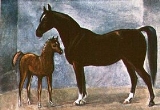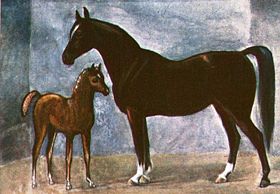
Thoroughbred breeding theories
Encyclopedia
Thoroughbred
horse
breeding theories run the gamut from the more common careful statistical analyses to the fanciful and the superstitious. The dream of the next legendary racehorse arising from the perfect pairing of sire and dam motivates the manager both for potential financial gain and for prestige. By careful analysis of bloodlines
, particularly the female line, the potential breeder can attempt to predict beneficial pairings.
" or female line, known as their "family", dating to the beginning of the General Stud Book
(GSB). This was done because the mares produce far fewer foal
s than stallions. Thoroughbred Stud Books around the world cite pedigrees in tail female style - meaning that the ancestry is traced through the maternal, rather than paternal line.
Horses that come from “good’ families will usually command better prices than one with an inferior family, although they may not prove to be better as racehorses or sires/broodmares. However, modern genetic studies have revealed that there are some cases where the haplotype
in the mtDNA of modern Thoroughbreds differs from the stated dam line, suggesting that some records contain errors.
He goes on to write:
 Old Bald Peg (family 6) is one of the earliest tap-root dams, having been foaled around 1635. Most, if not all modern Thoroughbreds trace their ancestry to her through one or both sides of their pedigree.
Old Bald Peg (family 6) is one of the earliest tap-root dams, having been foaled around 1635. Most, if not all modern Thoroughbreds trace their ancestry to her through one or both sides of their pedigree.
Many horses were inbred
or linebred in early years, which increased the chances of early horses appearing in many Thoroughbred pedigrees today.
During the 1950s Captain Kaziemierz Bobinski and Count Zamoyski produced the monumental work Family Tables of Racehorses, commonly known as the Bobinski Tables. This work expanded Bruce Lowe's numbering system of 43 families and identified a total of 74 families tracing to mares in the GSB. There were mares in several countries whose pedigrees had been lost or whose descendants had been bred up from Arabians etc. and were unacceptable to the GSB at the time of Lowe’s work. The Family Table of Racehorses expanded research into these female families of racehorses including:
Bobinski later updated his works and split Lowe's families into sub categories. Today, these numbers often follow a horse’s name in sale catalogues and pedigrees, much like a numerical surname and are very helpful for checking the accuracy of pedigrees and comparing the contributions made by various mares and families.
Thoroughbred
The Thoroughbred is a horse breed best known for its use in horse racing. Although the word thoroughbred is sometimes used to refer to any breed of purebred horse, it technically refers only to the Thoroughbred breed...
horse
Horse
The horse is one of two extant subspecies of Equus ferus, or the wild horse. It is a single-hooved mammal belonging to the taxonomic family Equidae. The horse has evolved over the past 45 to 55 million years from a small multi-toed creature into the large, single-toed animal of today...
breeding theories run the gamut from the more common careful statistical analyses to the fanciful and the superstitious. The dream of the next legendary racehorse arising from the perfect pairing of sire and dam motivates the manager both for potential financial gain and for prestige. By careful analysis of bloodlines
Heredity
Heredity is the passing of traits to offspring . This is the process by which an offspring cell or organism acquires or becomes predisposed to the characteristics of its parent cell or organism. Through heredity, variations exhibited by individuals can accumulate and cause some species to evolve...
, particularly the female line, the potential breeder can attempt to predict beneficial pairings.
The female line
Thoroughbred horses are traced through the "distaffDistaff
As a noun, a distaff is a tool used in spinning. It is designed to hold the unspun fibers, keeping them untangled and thus easing the spinning process. It is most commonly used to hold flax, and sometimes wool, but can be used for any type of fiber. Fiber is wrapped around the distaff, and tied in...
" or female line, known as their "family", dating to the beginning of the General Stud Book
General Stud Book
The General Stud Book was the original breed registry of the United Kingdom for horses. It specifically was used to document the breeding of Thoroughbreds and related foundation bloodstock such as the Arabian horse....
(GSB). This was done because the mares produce far fewer foal
Foal
A foal is an equine, particularly a horse, that is one year old or younger. More specific terms are colt for a male foal and filly for a female foal, but these terms are used until the horse is age three or four. When the foal is nursing from its dam , it may also be called a suckling...
s than stallions. Thoroughbred Stud Books around the world cite pedigrees in tail female style - meaning that the ancestry is traced through the maternal, rather than paternal line.
Horses that come from “good’ families will usually command better prices than one with an inferior family, although they may not prove to be better as racehorses or sires/broodmares. However, modern genetic studies have revealed that there are some cases where the haplotype
Haplotype
A haplotype in genetics is a combination of alleles at adjacent locations on the chromosome that are transmitted together...
in the mtDNA of modern Thoroughbreds differs from the stated dam line, suggesting that some records contain errors.
History of breeding theories
Around 1895 an Australian, Bruce Lowe, wrote: “Breeding Racehorses by the Figure System”. This work formulated a system of family numbers from the GSB mares as explained by Lowe:The figures are derived from a statistical compilation of the winners of the three great English classic races, Derby, Oaks and St. Leger. The family with the largest number of wins is No. 1, the next No. 2 and so on up to No. 43, and include families whose descendants have not won a classic race.
He goes on to write:
My own impression is that even these three great progenitors (referring to the 3 foundation sires) owe their survival and fame mostly to the female lines they were mated with. The Figure system is based mainly upon identifying and tracing the origin of these female lines.

Many horses were inbred
Inbreeding
Inbreeding is the reproduction from the mating of two genetically related parents. Inbreeding results in increased homozygosity, which can increase the chances of offspring being affected by recessive or deleterious traits. This generally leads to a decreased fitness of a population, which is...
or linebred in early years, which increased the chances of early horses appearing in many Thoroughbred pedigrees today.
During the 1950s Captain Kaziemierz Bobinski and Count Zamoyski produced the monumental work Family Tables of Racehorses, commonly known as the Bobinski Tables. This work expanded Bruce Lowe's numbering system of 43 families and identified a total of 74 families tracing to mares in the GSB. There were mares in several countries whose pedigrees had been lost or whose descendants had been bred up from Arabians etc. and were unacceptable to the GSB at the time of Lowe’s work. The Family Table of Racehorses expanded research into these female families of racehorses including:
- Families A1-A37 descend from American Stud Book mares who cannot be traced to the GSB
- Families Ar1-Ar2 are Argentine families
- Families B1-B26 trace directly to Prior's Half-Bred Studbook
- Families C1-C16 are described in the Australian Stud Book as approved Colonial Families
- Families C17-C33 descend from Australian and New Zealand mares who cannot be traced to the GSB
- Families P1-P2 are Polish families
Bobinski later updated his works and split Lowe's families into sub categories. Today, these numbers often follow a horse’s name in sale catalogues and pedigrees, much like a numerical surname and are very helpful for checking the accuracy of pedigrees and comparing the contributions made by various mares and families.

